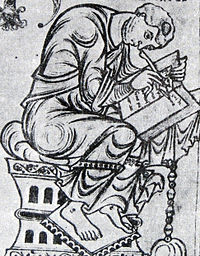Orosius

Paulus Orosius (/ˈpɔːləs əˈroʊʒəs/; lahir pada sekitar tahun 375, meninggal setelah tahun 418 M)[1] — kadang-kadang Paul Orosius dalam bahasa Inggris — merupakan seorang imam Kalsedon dari Gallaecia, sejarawan dan teolog, ia adalah murid Agustinus dari Hippo.
Lihat pula[sunting | sunting sumber]
Catatan[sunting | sunting sumber]
- ^ David Rohrbacher, "Orosius," in The Historians of Late Antiquity (Routledge, 2002), pp. 135–137. Rohrbacher bases the date of birth on Augustine's description of Orosius as a "young priest" and a "son by age" in the period 414–418, which would place his age at 30 or younger. Rohrbacher further speculates (p. 137) that Orosius may have died in a shipwreck while attempting to return to Hispania after visiting Palestine and Africa, since nothing is heard of him after 418, which is also the likely date of completion of his last book.
 Artikel ini menyertakan teks dari suatu terbitan yang sekarang berada pada ranah publik: Chisholm, Hugh, ed. (1911). "Orosius, Paulus". Encyclopædia Britannica. 20 (edisi ke-11). Cambridge University Press. hlm. 327.
Artikel ini menyertakan teks dari suatu terbitan yang sekarang berada pada ranah publik: Chisholm, Hugh, ed. (1911). "Orosius, Paulus". Encyclopædia Britannica. 20 (edisi ke-11). Cambridge University Press. hlm. 327.
Referensi[sunting | sunting sumber]
- Wikipedia Spanyol memiliki lampiran bibliografi pada: Anexo:Bibliografía sobre Paulo Orosio.
- Beberapa buku oleh Paulus Orosius
- Pacian of Barcelona, Orosius of Braga, in Iberian Fathers: v. 3,T he Catholic University of America Press, 1999; ISBN 978-0813200996
- Orosius, Seven Books of History Against the Pagans, Liverpool University Press, 2010; ISBN 978-1846312397
- Orosius, Old English History of the World: An Anglo-Saxon Rewriting of Orosius, (Dumbarton Oaks Medieval Library), Harvard University Press, 2016; ISBN 978-0674971066. Around the year 900, an Old English version was produced by an anonymous writer, possibly encouraged or inspired by King Alfred. The translator actively transformed Orosius s narrative: cutting extraneous detail, adding explanations and dramatic speeches, and supplying a long section on the geography of the Germanic world.
- Penerbitan pada Orosius dalam bahasa Inggris
- Linstädter, Marc-Antoine, Paulus Orosius - a Christian propagandist?, GRIN Verlag, 2013;ISBN 978-3638832410
- Van Nuffelen, P., Orosius and the Rhetoric of History (Oxford Early Christian Studies), OUP Oxford 2012; ISBN 978-0199655274
- Penerbitan pada Orosius dalam bahasa Spanyol
- Alonso Nuñez, José Miguel, “La metodología histórica de Paulo Orosio”, en Helmántica Nº 136-138, 1994, pp. 373–379.
- Beltrán Corbalán, Domingo, González Fernández, Rafael y Martínez Cavero, Pedro, “El Commonitorium de Orosio: traducción y comentario”, en Faventia: Revista de filología clàssica Nº 21, 1999, pp. 65.83. The complete text (in Spanish) from the article can be found on https://ddd.uab.cat/record/571. Consulted in October 2008.
- Fuentes De La Rosa, María Luisa, Orosio y su tiempo, 1st Edition, Madrid: Editorial de la Universidad Complutense de Madrid, 1990.
- García Fernández, Francisco José, “La imagen de Hispania y los hispanos a finales de la Antigüedad. Las Historiae Adversum Paganos de Paulo Orosio”, en Conimbriga Nº44, 2005, pp. 281–299.
- Mertínez Cavero, Pedro, El pensamiento histórico y antropológico de Orosio, 1st Edition, Murcia: Universidad. Área de Historia Antigua, 2002.
- Rábe Navarro Miguel Ángel, “Una interpretación de fuentes y métodos en la Historia de Paulo Orosio”, en Tabona. Revista de Prehistoria, Arqueología y Filología Clásicas Nº32, 1985-1987, pp. 377–393.
- Torres Rodríguez, Casimiro, Paulo Orosio. Su vida y sus obras, 1st Edition, La Coruña: Fundación Pedro Barrie de la Maza Conde de Fenosa, 1985.
Pranala luar[sunting | sunting sumber]
- Orosius's Historiarum Adversum Paganos Libri VII at Thelatinlibrary.com (in Latin)
- Orosius's Historiae Adversum Paganos at Attalus (in Latin)
- Orosius's History against the pagans Diarsipkan 2013-03-08 di Wayback Machine. (in English)
- Orosius as a source for Ibn Khaldun
- A collection of links on Orosius
- Opera Omnia by Migne Patrologia Latina with Analytical Indexes
- Orosius (c. 417), Alfred the Great; Barrington, Daines, ed., The Anglo-Saxon Version, from the Historian Orosius, London: Printed by W. Bowyer and J. Nichols and sold by S. Baker (dipublikasikan tanggal 1773), diakses tanggal 2008-08-17
